Managing the Digital Advertising Ecosystem to Create Value
The Digital Advertising Ecosystem
Digital advertising is the delivery of promotional materials through various online platforms, such as search engines, social media, websites, and other channels. Digital advertising’s growth has been as exponential as its impact, spreading to new platforms as they achieve critical mass, composed of a multitude of ad formats, delivery channels, cost models, networks, and tools, developing new platforms that facilitate as well as enhance the power of contemporary advertising. US online advertising increased from $27B in 2010 to $126B in 2019, or double the national TV advertising spend. Driven by technology, as evidenced by the annual Martech Map updated each year, as well as the tremendous natural benefits of the medium, digital advertising will continue to change, but is unlikely to recede in volume or influence in the near future.
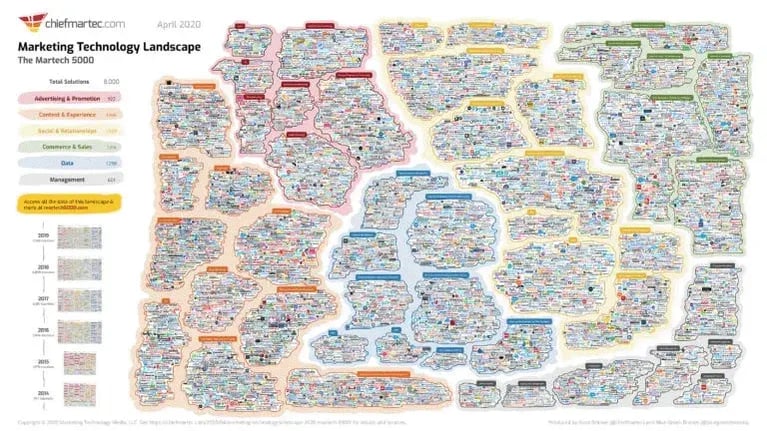
Customer expectations, competition, and the business benefits of the digital ecosystem drives organizations to create an online strategy to simply remain viable. For most products and services, consumers today have more choices, far more information on each choice (promotional materials, product websites, professional and user reviews), real-time pricing comparisons, and direct access to product and service vendors anywhere in the world. Leaders in any particular product space maintain foundational, evergreen digital ad campaigns to preserve market share, while brand challengers run creative and aggressive campaigns to secure a share of the market and acquire new category entrants. Finally, the benefits of digital advertising overshadow traditional advertising in nearly every area. Online advertising is more cost-efficient, offers flexibility for different situations and customer profiles (text, video, images, contextually placed or integrated in SERPs), is amenable to immediate measurement, surpasses in reach and speed, and allows targeting options to match elaborate sets of customer profile characteristics.
As a result, in some markets, not participating in the ecosystem is akin to not competing for customers at all, especially if organic search exposure is not competitive.
Strategic Goals and Tactics within the Ad Ecosystem
Creating strategic advertising goals and tactics within the digital ecosystem is part of an overall marketing strategy that defines customers, strategic advertising goals, and tactics that execute on strategy and is guided by the customer persona. While organizations may build successful advertising strategies within the ecosystem in more than one way, the degree of definition required to position the organization and its customers is consistent: successful strategic marketing plans define key elements of the current and future state with accurate, measured details that inform specific strategies and tactics.
A quick Google search for which type of digital advertising is the most effective will return untold numbers of articles purporting to define “top 5 advertising tricks,” or the “top converting ad format.” However, the best ad tactics are the ones that align with the strategy of the business. Rather than rely on general advertising best practices alone, advertisers must evaluate their business drivers and strategy in light of current business challenges, and create a supporting advertising strategy. Using functional knowledge of digital advertising channels, formats, and other elements, select the tactics designed to fulfill the demands of the ad strategy.
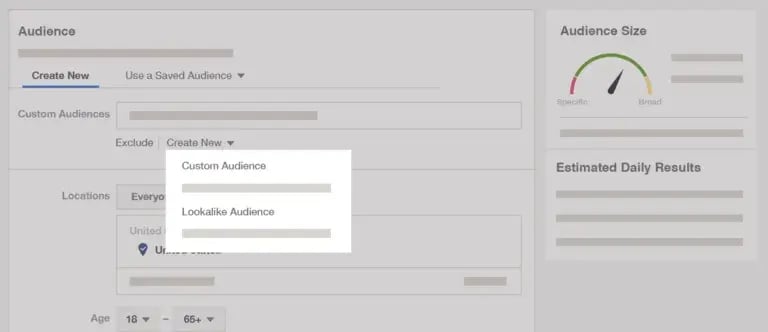
For example, If a business wants to expand its customer base and has captured the data of prior customers over time, segment that data by those that converted the quickest (or even became repeat customers). Load this audience into Facebook and build a custom audience using the “lookalike” audiences feature. The resulting new custom audience will share attributes and behaviors with the earlier successful customer segment that are not accessible as targeting options on Facebook such as interests, group membership, employment, and demographics. With an input of repeat customers, these lookalike targets will have a higher probability of conversion.
A strategic advertising goal should connect directly to core business goals.
Managing the Advertising Strategy and Tactics
Beginning a Digital Advertising Initiative
Managing an overall online advertising strategy and associated tactics can be nearly as complex as the digital advertising spectrum–assessing current and future overarching and specific goals, defining multiple buyer personas and the specific channel and ad combinations that best match their needs, defining measurement strategies, managing the build-out of one or more campaigns, and, of course, managing budgets across platforms.
Businesses define customer personas using actual data, typically pulled from existing and prior customers in the form of first-party data, collected directly from the consumer through interactions with the business, its website, ads, forms, etc. Representing actual customers, first-party data collected directly from the consumer is ideal for building personas, as it accurately reflects real customer characteristics and behaviors. Customer data of this sort likely includes purchase history, any forms or survey input, website visits and interactions, name, demographics, email address, or anything else the customer directly provides the business.
While this data is powerful in shaping customer profiles (and even segments of the customer journey), some businesses obtain 3rd party data from vendors, resolve customer identity (match 1st and 3rd party data), and create a much more comprehensive persona that captures interactions outside of the primary business channels, and reveals a more complete customer journey. Now the business can identify the earliest point a customer began researching a product, other products compared, and examine expanded lifestyle and demographic data. The more complete the customer persona, the more precisely the advertising strategy and tactics can be defined.
The Scope and Scale of Digital Advertising
Elements of Digital Advertising
Formats
Different ad formats are prominent in different channels and networks, but most formatting options are available across many platforms. Successful businesses learn that each format, and some combinations of formatting, often have sophisticated and unexpected tactical uses. For example, the Facebook Lead Ad can use a single image tied to a form and quickly build potential leads aligned with products. Below are the most common formats.
Text Ads
A typical text ad is a character-limited text-only advertisement containing headlines, descriptions, and usually, a visible “display” URL. Found in both Google Search and Display Ads, text ads can appear in the Search Engine Results Page (SERP), or on a website within the participating network. In the Display Network, text ads may sometimes run in native formats (the look and feel of the “host” website) or supplemented image formats (the text ad is replaced with the advertising company’s image choice or logo). Text ads are often used in Search Engine Marketing (SEM), as they integrate well into the SERP.

Google has specialized text ads that take advantage of underlying analytics that build the ad when it is served. Responsive Search Ads (RSA) are text ads that choose from a set of headlines and descriptions depending on what Google’s analytics engine finds most successful with a particular set of search request and user criteria. Dynamic Search Ads are text ads that are automatically generated by Google from content on the advertiser’s website. Text ads are useful in A/B testing, as minor changes in copy between ads can quickly reveal which elicits the better response. Text ads also benefit from their display simplicity: they may run in locations that are unable to display image ads.
Image Ads

Among the earliest ads, image ads were the original banner ads that typically used graphical text for an advertising call to action (CTA). Image ads are popular in the Google Display Network, as well as Facebook and other social media sites. Typically including a graphic related to a product or service along with a text message, image formats include static images, animated images, or even flash. Most publishers have specific size requirements for different placement locations. Visually appealing, image ads convey information quickly to viewers.
Video Ads
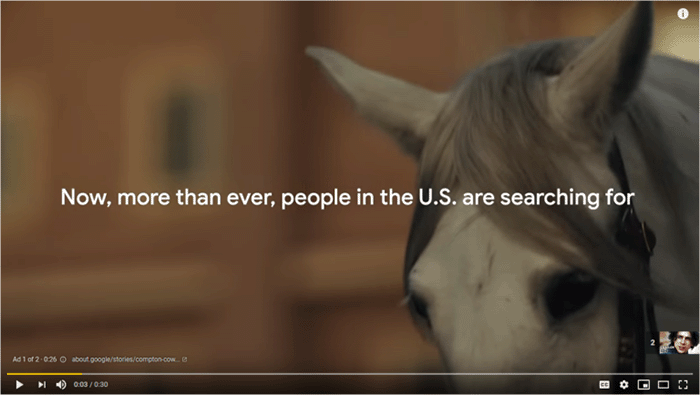
Among the most popular in gaining duration of views, video ads can be incorporated into existing content in a number of ways. In-stream ads appear before, during, or after other videos, commonly in YouTube or Google video partner sites, for example. Outstream ads are mobile-only ads that run on websites or apps residing on Google video partner sites. Video ads perform well for views and engagement. Because video ads incorporate audio and video, they tend to engage users to spend more time than image ads (users spend nearly twice as much time on a website which includes video). Nevertheless, more people will click an image ad than a video ad.
Native Ads
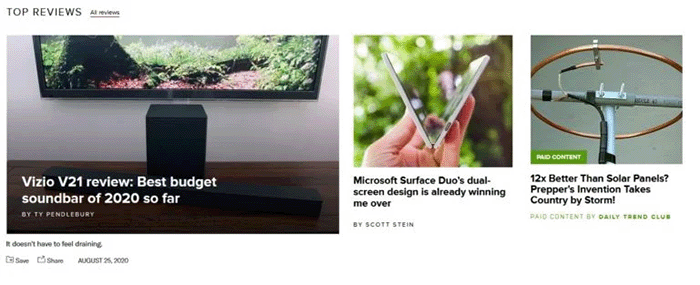
Native advertisements are formatted to appear as part of the website on which they are placed, and can be in a wide variety of formats: articles, image ads, infographics, etc. In most cases, the advertiser creates the content elements–text copy, graphics–and the publisher of the website dictates the styles that must be applied to the content for placement. Native ads are somewhat controversial, as no established standard exists for labeling native ads on different sites. As a result, one site might label the ad as “Sponsored Content,” while another omits any clear indication of a paid ad. Nevertheless, native advertising is more effective than traditional advertising, in part because readers are more likely to view ad content that appears to be part of the website and typically relates contextually to the site content.
Responsive Ads
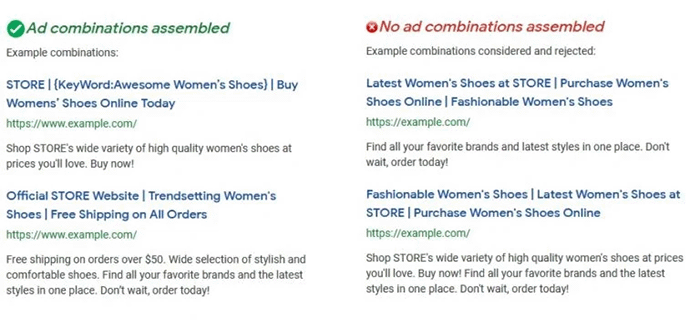
Responsive ad formats exist on several platforms, most notably Google Search and Display, where combinations of ad components, such as headlines, descriptions, square images, rectangular images, and videos are shown as impressions to users based on a combination of historical performance of those assets and, in Google’s case, the incoming signals about a particular user. Properly created ads of these types will serve specific headlines more appropriate to a given user based on that user’s prior search history and website visits. A similar feature on Facebook is called “dynamic creative” advertising.
Other Types of Ads
Many ad platforms have specialized formats, ad extensions, and beta offerings that are only accessible to certain advertisers and agencies who opt into those offerings.
Digital Advertising Platform Types
Display
Display channels provide versatile targeting based on context and unique audience segmentation. Combining specific targeting with awareness campaigns, advertisers using display channels can lift a new product out of obscurity by aligning their merchandise to a ready-made audience with a natural affinity for an unfamiliar product. For example, a new over-the-counter medication for cat ear irritation advertised on websites and groups dedicated to cat owners, or even cat health, may be able to promote awareness in a short enough time to enable a conversion-focused campaign.

Display channels have much lower click-through-rate (CTR), but the costs are also dramatically less. Challenger brands can reach audiences contextually or through affinity in a way not feasible with search campaigns, where brand leaders can not only outspend competitors, but also pay less per effort due to the brand name’s powerful influence on quality score, making their purchase of keywords much less expensive than the same keywords for an unknown brand.
More precision in targeting with Display-like advertising can help brands reach more users on smaller budgets, especially with remarketing campaigns that target users who previously interacted with the brand’s website, app, or social media accounts.
Search
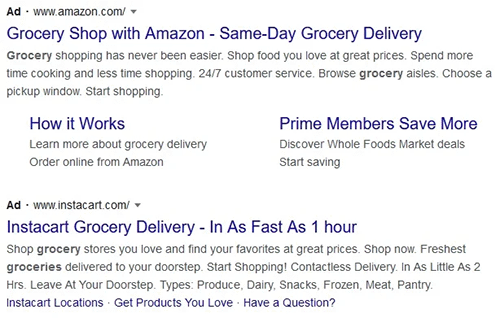
Search engine channels allow advertisers to reach consumers who are researching a purchasing decision, or they are already at the purchase point. Ads appear on the SERPs along with, and even above, organic results. Businesses use Search Engine Marketing (SEM) to reach motivated customers and to position their brand as a prominent option among results, striving to place their ad strategically within the results, above organic results, or on the first page of results. Unlike display ads, search engine ads are primarily aimed at conversions, whether completing an online purchase, or another key Call-To-Action (CTA) valuable to the business, such as completing an interest form, calling from a mobile phone, or signing up for a trial subscription. Search channels have a higher click-through-rate (CTR) than display, but at a higher cost generally.
Social Media

Social media ads have built-in targeting capabilities with self-segregated groups among the platform, and the users broadcast their affinities. Audiences can be built by simply selecting demographics and interests, or create custom audiences (e.g., retargeting), or “lookalike” audiences that allow a business to replicate the interest groupings of prior successful audiences. Social media allows images, video, and combinations like “Lead” that allows businesses to use images and video tied to forms that collect lead information. Costs vary across different social media platforms, with LinkedIn averaging over $5/click, Facebook at $0.96/click, and Twitter at $0.38/click. Impression costs are more closely aligned across platforms, however. Regardless, social media advertising is cost-effective for awareness campaigns, and uses electronic word-of-mouth effectively. In many cases conversions (goal completions) can be obtained at a low cost, especially where the precise targeting offered by user behavior and self-selected interests is harnessed to reach users matching a specific buyer persona. The added cost of reach to users who aren’t interested in a brand’s goods or services is balanced by the lower cost of advertising with a platform like Facebook.
Ad Purchase Models
A primary focus for most advertisers is the cost to obtain a lead or a transaction (sales). This can be expressed in many ways, all meaning approximately the same thing: cost per lead (CPL), cost per conversion, and cost per acquisition (CPA). There is a distinction between leads and sales, in that leads have a secondary (and sometimes tertiary) path from interaction to transaction (revenue) where sales are exactly as stated: actual transactions on an ecommerce platform of some type.
An important consideration is that ad purchase models can be configured with specific metric limits and goals, or the models can be established with other parameters in which these metrics are evaluated for efficacy and efficiency.
PPC
Pay-Per-Click (PPC) can be a cost-effective method to drive business, and the cost model charges advertisers only for “success” in the most limited definition–when someone clicks an ad and is carried to the relevant and targeted landing page. PPC is used in a wide variety of platforms, including Google Ads, Facebook, Twitter, Bing, and a great many more less obvious sites such as LinkedIn, Quora, and even Pinterest. Used in both search and display advertising, PPC advertising costs function the same; advertisers are charged for each click of the ad.
The average PPC for Google Ads across industries is about $2.50 for the Search Network and $0.50 for the Display Network. The average PPC for Facebook is less than $2. This budgeting method is often configured (or analyzed) as CPC, or cost-per-click.
Pay-Per-Click Advertising (PPC)
An Overview of the Pay-Per-Click (PPC) System What is Pay-Per-Click? Pay-per-click (PPC) is a model ...
CPA
Cost per Action or Acquisition (CPA) is a cost model in which advertisers are charged only when a user completes a designated action: completes an online purchase, submits a request for information, or another valued action on a website. When using CPA, an advertiser determines the optimum cost for a conversion, and agrees to pay that amount each time a visitor completes the designated conversion (purchase or other valued action). A prerequisite to optimal, successful use of the CPA model is an accurate business model identifying how much a conversion is worth to the business. The CPA model will consistently provide conversions at one price regardless of how many people click an ad or visit the website. When the upper limits of acceptable CPA are unknown, campaigns can be configured to determine benchmarks, then the metrics can be analyzed and limits adjusted (calibrating/tuning of campaigns).
The key advantage for the CPA model relies on the ad platform’s engine that drives the ad impressions. For Google Ads, this behind-the-scenes algorithm can evaluate the combinations of historical and real-time data and determine which combination of variables is most likely to result in a conversion. Consequently, Google Ads will serve the ad when the odds of success are highest, and work towards the goal CPA. The CPA model provides consistency of cost, and likely outperforms manual decisioning as well. The average CPA in Google Search Network across industries is around $50. The average CPA for Facebook is less than $20.
The business model dictates the conversion value.
CPM
Cost per mille, meaning per thousand, is a set rate paid for every 1000 displays or impressions. Typically used in display advertising when reaching a large number of prospects with shared affinities is the advertising goal. While inexpensive, the number of impressions may not directly relate to measurable results. CPM costs vary among platforms, but can range from $3-10 per 1000 impressions among popular sites, with Google Ads Display Network lowest at $3 CPM and YouTube highest near $10 CPM. CPM in general has been trending upward significantly and partly due to the increasing popularity of multiple social media platforms.
Digital Advertising Networks
Google’s Search and Display Networks dominate online advertising through ease of use as well as reach. Both networks leverage the Google Ads platform, allowing users to build campaigns for Search or Display, choose specific keywords, separate ads into ad groups, and set a wide variety of advanced parameters including targeting (affinity, in-market, remarket, geo, etc.) and tracking. Google also owns YouTube and supports both video and image format advertising on YouTube and anywhere a YouTube video is embedded.

As the most widely-used search engine in the world, Google Search is a popular platform for SEM, offering PPC and CPA cost models. In addition to text ads, Google Search supports Dynamic Search Ads, Call-only Ads, Responsive, and Shopping Ads. Display Network ads include Text, Rich Media, Image, Video, and Responsive.

One of the social media leaders, Facebook’s large audience and advanced targeting are popular with advertisers for quite a while, as Twitter and others continue to gain share in the user and advertiser base. Able to combine multiple multimedia elements and functionality for ads, and providing advanced targeting with little effort, Facebook advertising is powerful for not only awareness campaigns, but successfully drives leads in targeted campaigns.
Facebook cost options are broad, including CPC, CPM, CPA, and CPL (cost-per-like), and both manual and automatic bidding are offered. With automatic bidding, Facebook adjusts an advertiser’s bidding strategy to aim for a lowest cost per click or action. As expected, manual bidding provides the business with total control over the bidding strategy. Also, as in Google’s case, manual bidding is rarely the most effective solution for large campaigns and use should be limited to creation by advertisers with the most expertise.
DSP
A Demand Side Platform (DSP) is an automated buying platform that brings together advertisers to purchase ad space, and ad exchanges that maintain digital advertising inventory of publishers. Digital advertising inventory is merely digital ad options such as image ads on websites, mobile ads, and video ads. An ad exchange connects advertisers who buy and publishers who sell advertising space using real-time bidding (RTB) just as Google Ads uses RTB. DSPs allow advertisers to purchase ad space across many sites simultaneously, in real-time–all from one interface. A multitude of DSPs exist, all with different inventory across many placement locations.
DSPs manage the placements, making the advertising process as simple as Google Ads. While there is a wide range of DSPs with differing features (different placements, targeting, tagging, etc.), some DSPs offer advanced techniques not available to most advertisers in networks like Google Ads.
Targeting and retargeting can be sophisticated and precise, allowing retargeting windows start and stop relative to multiple actions, excluding segments during the retargeting, even changing ad behavior for specific individual users. Targeting can be based on IP addresses, type of internet access, device type, device OS, and based on specific websites, blogs, social media they visit.
DSPs provide real-time statistics over all the advertising inventory sources, allowing advertisers maximum control to manage campaigns and budgets at a level of detail equal to or beyond traditional ad networks. There are a large number of DSPs available, and they are not all equal. Many online sources detail popular DSPs, their features, and number of users for each.
Private Marketplace
A private marketplace or PMP is a closed advertising marketplace where elite/prestigious publishers offer ad inventory to a select group of advertisers, providing publishers with more control over the advertisers and companies that ultimately place ads within their controlled inventory. Often these platforms are invitation-only. Competition from premium advertisers drives price as the targeted digital properties are in demand. Advantages for transactions on a premium private exchange include efficiencies for publisher and advertiser in quickly completing transactions and placing ads live on top websites. The entire transaction is transparent to all parties, so that the inventory and cost are clear to advertisers, and the creatives and participating business is vetted for the publisher. Technology reduces cost for an in-person staff to manage the transactions. And finally the advantages of a PMP for a segment of the advertising market is strong enough that PMPs are becoming a standard part of many large programmatic exchanges.
While ad networks like Google and Facebook dominate the industry (approximately 4M businesses on Google and 3M on Facebook), many companies choose other lesser-known networks for driving traffic and targeting leads. Costs associated with the leading networks, as well as increased advertising restrictions, drives some businesses to alternative networks.
Choosing Elements Aligned with Strategy
Knowing what each format or channel is and how to use it is half the battle; converting an advertising strategy into tactical elements that accomplish goals is a more common fail point. A relatively newer business may want to challenge a leading brand for a share of the market they currently dominate. They could design text ads that parallel the target brand’s evergreen campaign, and bid for the leading brand’s keyword in a search campaign; they could build a customer persona for the leading brand and aggressively target this customer segment where the brand leader advertises. But while both of these tactics speak to the challenger’s goal (increase market share by advertising to the leading brand’s customers), they omit their own position in the equation: as a new, upcoming challenger to a dominant brand, they cannot match the leader’s spends. They cannot compete in saturation marketing, and must be precise with campaign choices that get the most mindshare for the least investment.
There are best practices depending on the goals, buyer personas, and marketing budgets of a business.
A business must account for its market position as part of an advertising strategy.
Instead of competing for keyword bids or ad spends, use channels and ad formats that most effectively support precise targeting of the competitor audience for the least investment. Businesses seeking to challenge brand dominance must, of course, have differentiators compelling enough to convert the competitor’s customers once they are exposed to impactful ads–whether price, features, or some other niche that encourages customers to switch brands. The Google Display Network supports extensive combinations of targeting options at a relatively low CPC. Social media like Facebook and Twitter also have built-in audience segmentation by natural groupings as well as custom audiences. Using Google’s Display Network, a challenger can use a custom affinity audience targeting the competitor home page to place the compelling message in front of prospects. When setting up audiences for Facebook ads, the challenger can select users whose interests include the dominant brand. Finally, a clever competitor can create short video ads and target the brand leader on YouTube; each time someone searches for the brand, the challenger video ad plays first. Note that targeting popular brands is costly; it can be less expensive to find the contextual keywords that are not controlled by those popular brands.
Marketing Strategic Planning
Using a Framework to Achieve Goals The Value of Marketing Plans Cecilia’s Coffee Bean ...
Driving Traffic for Value
Organic Traffic
Definition
Any traffic to a website from a search engine not resulting from paid listings is organic traffic. These visitors used a search engine like Google or Bing to find the website, but did not click a paid ad in the SERP to get there. Users who clicked on a paid listing, conversely, are considered paid traffic. Still, other ways are used to create traffic for a website. Direct traffic includes traffic that comes directly to a site without using a search engine or a link, and traffic may also be generated via social networks, email links, or referrals from other websites.
Value
Organic traffic is powerful, delivering more traffic that other paid channels, including display, email, referred, paid search, and social media. Paid search will outperform in conversions, but more people arrive by non-paid links or direct, by typing the domain and navigating to the desired page. Organic traffic is earned or owned traffic. Visits from paid traffic will cease if the paid advertising stops; organic traffic is based on characteristics of the site, and continues as long as the site is maintained.
Most marketers use a combination of organic and paid traffic; in these cases, strong organic traffic flow decreases the cost of paid traffic. A high-ranking site with domain authority will spend less on the same keywords as a site with low domain authority for those same keywords.
Increasing Organic Traffic
The general practice of increasing organic traffic from search engines is typically called Search Engine Optimization (SEO). Optimizing for search engines entails modifying the website to increase its search engine ranking, increasing the site’s authority and the likelihood it appears as an organic link in the SERPs. An entire field of practice exists for conducting SEO for clients, combing through target websites and modifying a dozen or more site and page attribute types that impact how search engines catalog and retrieve the site for queries. The bottom line: increasing traffic with SEO means making the website popular and ensuring that search engines can identify key positive attributes in place. For example, quality backlinks serve both purposes: the number of quality sites linking back to the business website is indicative of popularity and one of the key ways to drive organic traffic, while the backlinks are an evaluation factor for search engines. Creating high-quality engaging content for the site naturally drives site popularity.
Another common SEO technique is increasing site usability: improving site speed, adding shareability to pages and posts, compressing and optimizing images, and making the site mobile-friendly. Finally, reinforcing keywords will drive organic search traffic: Optimizing titles and headings targeting proper keywords, making keyword page names prominent in site navigation, interlinking pages with keyword-rich anchor texts, and content marketing that increases the interconnected keyword topics throughout the site.
Paid Traffic
Definition
Paid traffic is any traffic to a site that requires pay to obtain. While paid traffic would include any traffic resulting from pay–even a television ad promoting the website–most paid traffic is familiar formats and channels like extended text ads in search engine marketing (SEM), or display ads in Facebook directing users to the target landing page.
Value
All things considered, PPC advertising is often inexpensive, and relatively simple to develop and implement. Paying for only the click-throughs means the cost is limited to actual visitors to the site, whether they bounce or convert. Basic paid traffic-generating advertising such as contextual image ads on the Display Network or expanded text ads in search advertising, provide significant targeting and segmentation features making it easier to get ads in front of likely customers. For short-term gains, paid campaigns are often superior to any SEO-type work because the results are immediate and can be tuned to improve those results quickly.
Enhancing Paid Traffic
Increasing paid traffic can be achieved by increasing ad volume or optimizing the ad strategy to drive higher click-through-rate (CTR) or increased conversions. While the former is not a likely strategy, optimizing ad campaigns can increase traffic while reducing spends.
Paid and Organic Traffic Synergies

Organic and paid traffic are integrally linked, as decisions, changes, and improved traffic for one, inevitably impact the other. Improving organic traffic through SEO efforts can improve the websites ranking (e.g., Domain Authority, or DA) which makes paid traffic (CPC) less expensive. Keyword research drives traffic in both worlds. Keyword research in SEO underpins engaging, unique content that drives traffic naturally to the site. In paid traffic (SEM), keyword research is required to determine which keywords to bid on for advertisements. More importantly, however, advertisers can identify which keywords need more coverage on the website by reviewing search results and converted traffic. Ensuring new content is anchored and interlinked by keywords that drive conversions is one of the simplest ways to increase organic traffic and reduce advertising costs simultaneously. Working with both forms of traffic collaboratively allows a balanced, planned approach using the best practices of each way of increasing traffic.
Tying it Together
The Digital Ad Ecosystem is a large and complex system with a multitude of components, each with specific features, purposes, and functions. Knowing something about the different formats available, the platforms they reside on, or even the different cost models often associated with different channels and platforms, all of these are required. However, these lose a great deal of efficacy if not used collaboratively and in service to a coherent digital advertising strategy, which, in turn, is aligned with a business strategy. A scattershot advertising approach will hit and miss, obtaining a few results, some good and some bad, but it’s little more than isolated spends, based on little to replicate or connect back to the business or other promotional efforts.
Businesses that use strategic planning, and model the same approach when developing advertising strategy and tactics, are prepared for data-driven advertising that takes full advantage of all the elements in the Digital Advertising Ecosystem.







RESPONSES